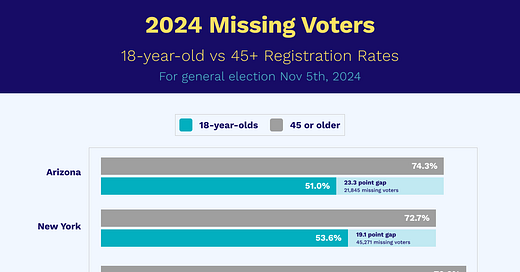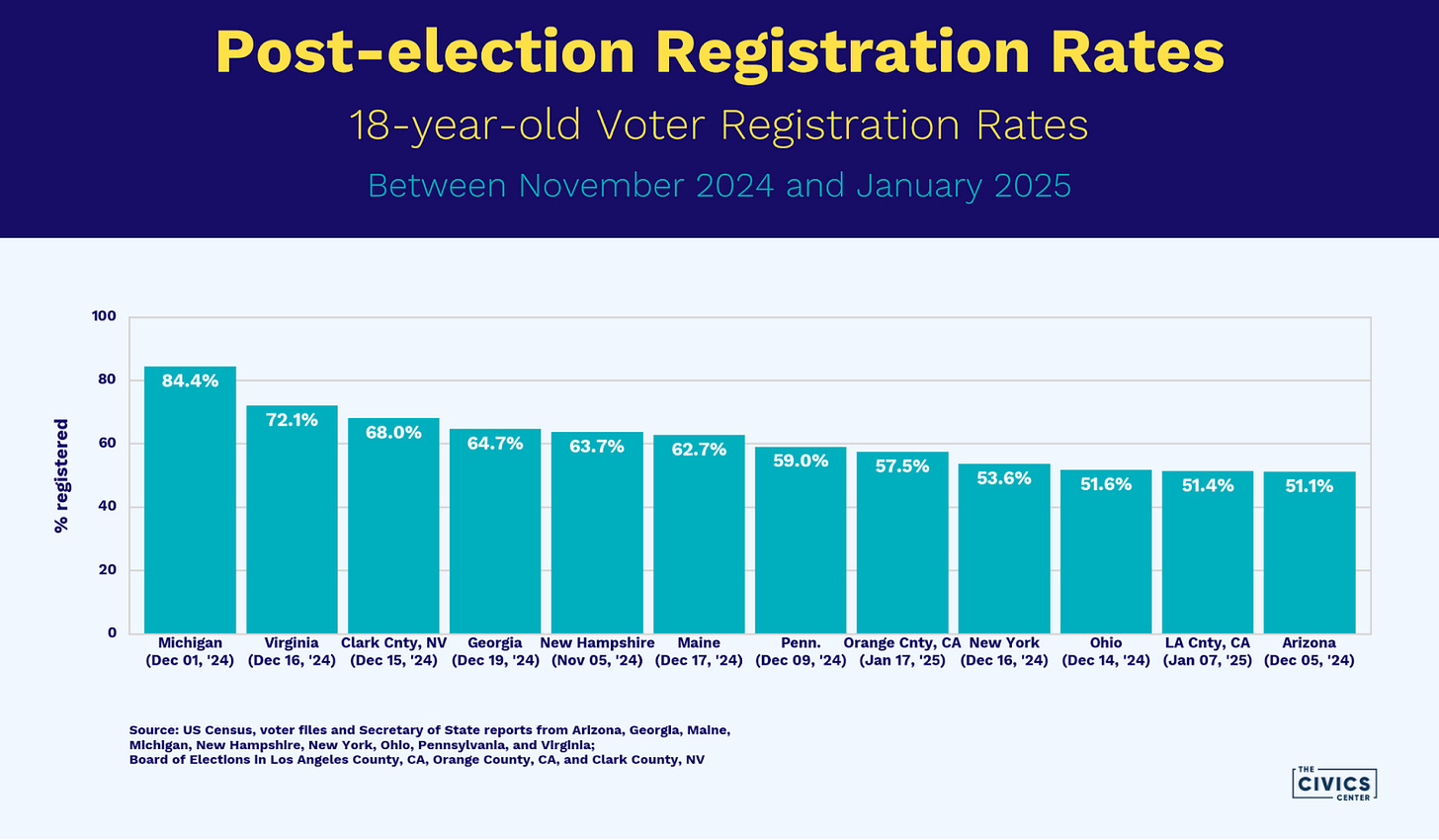NEW 2024 YOUTH ELECTION DATA: The youngest voters were massively under-registered to vote in the 2024 election
Persistently low youth registration is a long-lasting and serious problem facing our democracy. Unlike many other democracy challenges we face, this one is eminently solvable.
The youngest voters were massively under-registered to vote in the 2024 election. This may not be a surprise to those who have decided–incorrectly–that young people are simply apathetic and therefore it’s a fool’s errand to try and engage them. But we at The Civics Center know they care, and believe it’s a failing of our society and that we can turn it around with a better approach. If we’re going to strengthen our democracy, increasing youth registration, which is critical to participation, has to be a priority.
Unlike many other democracy challenges we face, this one is eminently solvable.
The full national voter file, including turnout data, is not yet available for analysis. But at The Civics Center, piece by piece, we are building the data infrastructure to help everyone see whether and where the youngest voters are joining our democracy by registering to vote. We now have post-election registration data from multiple states, straight from official voter files or secretary of state offices.
The take-aways are sobering and have gone completely unreported by others. Here’s what you need to know from our study of nine states and several large counties.
Arizona, New York, Ohio, and Pennsylvania all had registration rates for 18-year-olds of under 60% measured at or shortly after Election Day. If the 18-year-olds in just those states had been registered at the same rates as voters age 45+, it would have meant 133,000 more voters just in those four states. If they had achieved 100% registration, it would have meant 295,000 additional 18-year-old voters in those states.
Here’s the breakdown of missing 18-year-old registrants to achieve parity:
None of these four states with registration rates below 60% for 18-year-olds offers same-day voter registration. Among these four states, only New York offers pre-registration starting at age 16, and in New York, despite legislation seeking to require high schools to offer voter registration, implementation has been far from robust and universal. The result is that the state sees exceptionally low levels of voter registration for 18-year-olds in New York City and the surrounding counties, as shown in the maps below, which compare rates for 18-year-olds by county with those age 45 and above.
We have registration numbers for both 18-year-olds and those 45+ for seven states in total: Arizona, Georgia, Maine, Michigan, New York, Ohio, Pennsylvania. Among all these seven states, the average gap between registration rates for 18-year-olds and those 45 and above is 18.2 percentage points, representing nearly 375,000 missing 18-year-olds compared to full registration in those states and 170,000 compared to parity with those 45 and above.
Below is a comparison chart showing voter registration rates for 18-year-olds in the nine states and three counties for which we have post-election numbers of 18-year-old registrants.
Michigan and Virginia, the two top states, both offer preregistration beginning at age 16 and both offer same-day voter registration. Nevada, where we have data for Clark County (encompassing Las Vegas and the surrounding communities), offers same-day voter registration and preregistration beginning at age 17.
Coming in our next data report will be data showing the sharp decline in voter registration for 18-year-olds since Election Day. Those already registered are aging out of the category, and those who are turning 18 are registered at very low rates. Registration spikes around major national elections are not enough to solve the problem for the long term. What it takes is resources and consistent organizing.
In every midterm election of this century, fewer than 35% of 18-year-olds have been registered to vote. More than 5 million 18- & 19-year-olds have been left out, as illustrated here:
If you’ve read this far, I have a couple of questions for you: Do you want this cycle to repeat in 2026, or do you want things to change? Do you want to see young people registering to vote at the same rates as older Americans, or even higher?
We know what works, because we track these numbers and have tested our program: making voter registration part of high school life. One year at a time, we could end the cycle of low youth registration, low youth turnout, and low levels of participation overall.
The cost is moderate compared to other interventions and minuscule compared to the $10 billion spent just on ephemeral advertising for the 2024 election; the impact is concrete, lasting, and has potential for long-term, systemic change. Once student-led voter registration drives get embedded in school communities, it is straight-forward and much simpler for the program to continue from one year to the next. Creating the motivation and infrastructure to engage high school students in this work every year, without pause, is how we make change.
We know from our efforts that almost no one is talking to high school teens about how registration is a necessary step to voting, how to do it and organize their friends to do the same, and the difference they can make when they do.
Low registration rates breed cynicism. Candidates and campaigns often rely on voter files for their outreach and turnout efforts, but if teens aren’t registered, they don’t appear in the voter file and are therefore not reachable within the budget for most campaigns, especially in primaries and for state and local offices. With so many young people missing from voter files, candidates too often do not take their concerns into account. Young people then feel ignored (because they are), and the vicious cycle continues. We can’t expect teens to register if no one is asking them and explaining why it matters; we must demand better for our up-and-coming voters.
Current systems are not getting the job done:
College VR programs don’t reach the 40% who don’t go on to college.
40% of 18-year-olds don’t get driver’s licenses, meaning that DMV-based VR systems miss them.
Most online VR systems require a driver’s license, so these systems, which are supposed to be easy and accessible, fail to serve large numbers of young people, too.
But nearly every American can be reached in high school, where they are old enough to register BEFORE they graduate.
These are some of the central insights guiding our work: providing data, training and resources to make voter registration part of high school life. In 2024, we sparked and supported voter registration drives in more than 300 schools. More than half of them were Title I schools, meaning we served those most in need.
We now have three different independent studies showing that communities with drives through our work experienced a greater than 6 percentage point increase in 18-year-old voter registration versus comparable communities without drives. We accomplished this on a small budget focused on education, organizing, partnerships, community building and the data and training resources to measure and support it all. These efforts represent a foundation for lasting, systemic change.
All of our leading program indicators are up this year compared to any year in our history. Most organizations that work on voter registration in the year after a presidential election see the opposite. We have drives in 20 high schools already scheduled for this Spring, as part of our Cap, Gown & Ballot initiative to ensure Seniors are registered before they move on. We’ve been going to conferences, where hundreds of educators have met with us and enthusiastically accessed our resources. Attendance is up at our training workshops.
High school students and educators are not taking a break. They want to turn these numbers around. Here’s proof that they are not apathetic:
What young people and educators need from us is resources, and that is what we need from you. The urgency is real: graduation season starts in May and continues through June. What that means right now is that four million high school seniors are about to get their diplomas. If they graduate without registering, they will be much harder to find and to engage later on, and the cycle described above will continue.
If we can reach them now, however, it means we’ll be helping them develop an appreciation for democracy, and it means candidates and campaigns will know how to find them. When they register with their peers, it’s more likely they will be paying attention.
It takes funding for us to reach them. Funding goes to gift cards ($150), our Democracy in a Box toolkit ($100), stipends for educators ($500), and the training, resources, and support that helped us spark and support drives in 350% more schools in 2024 than in 2022 (priceless!!). We want to continue. The students and educators want to continue. And we need resources to do that.
If you want to be part of turning around the story of low youth participation, please donate today:









Laura, thanks once again for this helpful post that provides so much valuable information.
Forwarded this article to several people including: the high school seniors some of us are working with; also another student, a junior, who wants to help with voter registration this spring and will still be around in the fall.
Also sent it to the county clerk. In a conversation last week she told me we would have to contact the KY Sec. Of State to get information on new young voters.
So I’m working through that online paperwork. It’s all a process.